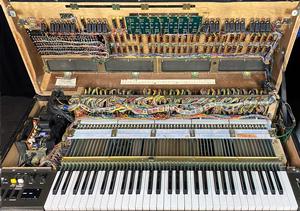“It was the best of times, it was the worst of times, it was the age of wisdom, it was the age of foolishness, it was the epoch of belief, it was the epoch of incredulity…” But enough about 2022. The Yamaha CS-80 is one of the most revered, sought after and – from a technical perspective, crazy – synths ever made. Opening one up and peering inside feels like the synth equivalent of Howard Carter seeing King Tut’s tomb, or the end of a disaster movie where the protagonist has to defuse a fiendish ticking timebomb: they are insanely complex beasts with inch thick wiring looms and a bewildering array of boards, components and synthy gubbins (should anyone be wondering, I feel I should point out here that I am not a technician).
SYNTHS OF WRATH
They have been steadily climbing in value for some years, though the last couple of years has seen vintage synthflation reach alarming levels, which are out of all proportion to good sense. In many cases, one can understand why revered synths such as Moog Modulars, Roland System 700s (and even Jupiter 8s) have increased in value – they are iconic, in short supply, sound fantastic and can be serviced by a competent synth technician. The larger Yamaha CS series synths qualify on this basis, though unlike the aforementioned others, they contain unobtanium proprietary Yamaha chips that, when they fail, can only be obtained by sacrificing another expensive and rare vintage Yamaha synth (for those curious to see this rare silicon, the shot below is the two YM266 ICs in one of the CS-80s).
LORD OF THE SYNTHS
And then there’s the CS-80, which adds to that a servicing mountain of Himalayan proportions that must be climbed if one is to achieve some semblance of an instrument that functions as the Yamaha designers intended. As the years roll on, even relatively simple vintage synths such as Roland’s Juno series, are presenting with increasing numbers of faults and failed components that were almost unheard of a decade or two ago. The CS-80 is in another league entirely and it is my opinion that asking prices are soaring out of all proportion to the reality of what owning and maintaining one of these incredible synths entails. It’s the synth equivalent of owning a vintage Ferrari – sounds wonderful and is a thing of great beauty and joy to use, but painful and expensive when it goes wrong.
WUTHERING SYNTHS
Prices for those listed on Reverb lately have become truly insane, even by that site’s feverishly overheated standards – we’ve seen six figure asks from private sellers for unserviced examples that I hope nobody actually bought. Dealer prices for examples freshly overhauled by a competent tech are routinely heading towards the £50k mark, which still seems a lot to me, but at least the buyer can expect a synth that works.
We are still dealing with the hangover of over-enthusiastically selling four CS-80s last year: and the extended pain of overhauling them to head tech, James Walker’s exacting standards. Our synth queue is just starting to recover so we are taking a break from servicing CS-80s for the foreseeable future. Thankfully for the synth community in the UK, Kent Spong is still in business and keeping these monsters performing.
GREAT EXPECTATIONS
When I received a call from a gentleman with not one, but two CS-80s to sell, I made it very clear that of course we’d be happy to help, but on the condition that we sell them as found, rather than serviced! It was a bonus that they were located within an hour of Soundgas HQ. We don’t get out often so head synth tech James Walker and I booked a day out and ventured forth excited by the prospect of seeing two CS-80s in the same place (that are not on, or destined for, James’ bench!). The original owner was sponsored by Yamaha back in the seventies and was a big CS-80 user: and of course given what we know about these complex synths, if you’re going to gig them you need (at least) one spare… They’d been dry stored and left untouched for the best part of a couple of decades. From the outside, both looked less than pristine but we set up some lights in the chilly studio live room and prepared to open the first one.


